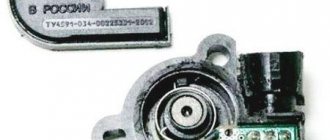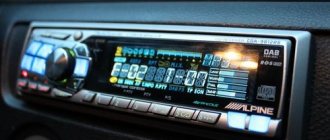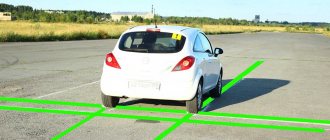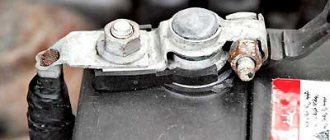Pull out the suction a little
The colder the car engine, the more difficult it is for it to start on a regular warm-air mixture. The purpose of the suction is to enrich it. The suction is used as follows:
- The longer the car has been standing on the street and the lower the thermometer readings, the more the choke needs to be pulled out. If the engine is completely cold, pull the handle completely towards you. In most cases, this helps to raise the speed to 2000 or more.
- Gradually remove the handle until the minimum stable speed is reached. At the end you must return it to its previous position.
- You should not drive a car with the choke pulled out. This way you risk flooding the spark plugs and the engine will refuse to start at all.
Starting a carburetor engine in cold weather
Winter has come. Along with it came problems with starting a cold engine in cold weather. Everyone solves them in their own way. Some people park the car in a warm garage, some take the battery home at night, some heat up the engine sump from below in the morning. Particularly advanced ones install preheaters for oil or coolant.
But we will be interested in the situation when the car stood on the street all night, well, at best, in a cold garage or under a canopy. And the temperature outside tended to drop to 25–30 degrees Celsius.
In general, it is worth noting that the car owner whose car spends the night in such conditions should prepare in advance for winter.
Checking the readiness of the car engine to start in winter
Check the battery. Replace the old one, or put it on charge, even if there have been no problems with it yet.
Pay attention to the oil in the engine. It is better not to use mineral water in winter. Semi-synthetic or synthetic will make starting the engine much easier in difficult conditions.
Check spark plugs. If you have already had problems with them in the warm season, then it is better to play it safe and buy a set of new ones, at least as a reserve. You can also slightly reduce the gap between the spark plug electrodes.
Check and, if necessary, adjust the carburetor . Without his clear work it’s like having no hands. You can arrange a complete inspection of your carburetor, but if it worked fine before, then I think you shouldn’t get carried away with it.
So, it’s a winter morning and you’re alone with a piece of iron frozen by frost and wind. Everything would be fine, but we need to somehow revive it.
Starting a carburetor engine in cold weather
Open the hood and use the manual pump lever on the fuel pump to pump fuel into the carburetor.
We sit in the cabin, turn on the high beam headlights a couple of times for 5-7 seconds. This way we can revive the battery a little.
Depress the clutch pedal several times
Press the gas pedal several times, wait 10-15 seconds
Pull out the “choke” handle
We turn the key in the ignition and rotate the crankshaft with the starter as long as possible (10-15 seconds) until flashes appear in the cylinders and the engine starts, without pressing the gas pedal.
Ideally, start the engine on the first try. If it doesn’t work, then we do everything listed (except for turning on the headlights) again after about five minutes.
In case of failure, you will need to replace the spark plugs and charge the battery; you can “light it” from the battery of another car. Read more about problems with starting a cold car engine on the page “Cold engine does not start.”
Happy winter launch!
TWOKARBURATORS VK -More information on the topic in our VKontakte group
More articles on VAZ car engines
— The spark plugs are flooded, what should I do?
— “Troyt” engine
— The idle speed of the carburetor engine “floats”
— Black smoke from the muffler
- Shoots at the silencer
— Engine crankcase ventilation system with Solex carburetor
Depress the clutch
Even a running car engine can stall if the thermometer drops below 30°C. To prevent this from happening, he needs help by squeezing the clutch:
- At the moment of starting, press the gas pedal.
- As soon as the speed has stabilized, remove your foot and release the clutch to neutral.
- Level the speed using the choke to above 1500 rpm. At low winter temperatures, values of 2000 rpm are acceptable.
This simple action will significantly reduce the load on the engine.
Starting a car with manual transmission
In order to remember how to start a car manually, you need to understand what helps and what prevents the car from starting. Firstly, fully charging the battery makes starting the engine easy and relaxed. Secondly, disabling the gearbox by pressing the clutch pedal all the way allows you to significantly reduce the load on the starter at the time of starting.
How to start a carburetor car correctly? If the engine is equipped with a carburetor, it is necessary to extend the manual fuel suction lever all the way to ensure that it enters the fuel system in sufficient quantity. After starting the engine, you need to return the lever to its normal position.
How to start an injection car correctly? Such cars are equipped with an electronic control unit that independently regulates the process of preparing the fuel mixture. Interfering with its operation by pressing the gas pedal can only complicate the process of starting the engine. You can derive a simple algorithm for starting a manual car:
- put the car on the parking brake;
- press the clutch pedal to the floor;
- In a carburetor car, pull out the choke lever all the way;
- in a fuel-injected car you don’t need to press anything;
- start the engine with the ignition key;
- move the choke lever to the initial position.
How to start a VAZ in severe frost
❶ How to start a VAZ in severe frost
You will need
- — the battery is in excellent condition;
- - dry calcined candles;
- - liquid - ether-based spray.
Instructions
To ensure that the battery is in good condition, place it in a warm place overnight and do not forget to charge it on time. It plays a huge role in ensuring that there are no problems when starting the engine in cold weather. In winter, the battery loses its capacity by almost a quarter, which means that the starting current also drops.
If, nevertheless, the battery remains in the car, and in the morning the car does not want to start, then first warm up the battery by turning on the high beam headlights for 10-20 seconds. Or bring it into the house and place it at low currents to recharge. After this, put the prepared battery in place. When starting the engine, first depress the clutch, and only then begin to “turn” the starter.
After you warm up the engine, begin to smoothly release the clutch in order to warm up the transmission. If you have an engine equipped with an injector, then if the start fails, try using the cylinder purging mode. If this maneuver fails, then your spark plugs are most likely flooded. Remove the spark plugs and heat them.
Spray an ether-based liquid into the carburetor (behind the air vent). This is one of the effective methods for starting a carburetor engine. In an engine with an injector, this liquid must be injected into a corrugated hose, also behind the air vent.
To ensure that the frost does not take you by surprise, prepare your car for the winter period. To do this, install new spark plugs, replace the antifreeze, and fill the washer reservoir with antifreeze. Put winter tires on the wheels, install plastic fender liners in the wheel arches, and pour some WD-40 into the door locks. If you follow this simple guide, your car will be “on the move” even in severe frosts.
Video on the topic
note
Be careful when using spray starting fluid. It shortens the life of your engine as it washes oil from the cylinder walls.
Helpful advice
In cold weather, do not put the car on the handbrake for a long time, as this will cause the brake pads to freeze to the drums.
Sources:
- how to start a vaz 2106 in cold weather? what methods??
www.kakprosto.ru
How to start a VAZ engine in winter
Content:
The winter period has always been difficult for car owners. Significant troubles are caused by difficult road conditions, which change frequently and are quite dangerous. The car itself creates additional problems. Low temperatures do not contribute to easy starting and stable operation of both the engine and other components of the car.
All technical fluids and lubricants freeze due to low temperatures and cease to be fluid; you can find out which oil to fill in in winter here. Because of this, the rotational resistance in components and mechanisms increases significantly and it is very difficult for the starter not only to spin, but even to turn the crankshaft. And if we add here wear, violation of system adjustments, and the exhausted life of some elements, then the chances of starting the power plant at low temperatures are greatly reduced. And yet, winter is not a reason to put your car in the garage until spring. With the correct actions and following certain recommendations, starting the engine is quite possible.
And yet, a car is a convenient and comfortable means of transportation, so many cannot refuse to use a car even in severe frosts.
Next, we’ll look at how to start a VAZ in winter. These cars were chosen because they are among the most common, and also because of the power system - some of them are equipped with a carburetor system, but there are also injection versions. That is, these cars use the two most common power systems in our country.
Preparing a car for winter
So, preparing the car begins even before the cold weather begins. A little preparatory work will make it easier to start the power plant of this car at low temperatures.
The first thing you need to take care of is the battery. Before frost sets in, you need to carry out a full range of maintenance work on it - check the density of the electrolyte, and, if necessary, bring it to the required level. Also fully charge it.
If the engine oil has almost exhausted its service life, then you should not wait for this to happen and replace it while it’s still warm. The use of mineral oil is strictly not recommended. If in summer it is still suitable for use, then in winter such a little can lead to engine failure. At low temperatures it thickens greatly and when starting the engine, there is a possibility that the thick liquid will simply squeeze out the crankshaft oil seals.
We'll have to work on the power system as well. It doesn’t matter which system is used on the VAZ, you will need to flush the system and replace the fuel and air filters.
It would be a good idea to check the valve adjustment and ignition system. Spark plugs must be carefully inspected and cleaned, and their gap adjusted. It would not be a bad idea to purchase a new set of spark plugs “in reserve”, and they should always be in the car.
The car's cooling system is also worth looking at. If it is filled with antifreeze, which has been used for several years, then it is better to replace it with a new one.
Article on the topic - What is better antifreeze or antifreeze for VAZ
You can, of course, purchase a pre-heater for your car, but its cost is significant and not everyone can afford it, so we’ll do without them.
Some craftsmen “manage” to install heating elements operating from a 220 network in the oil pan. The idea is good, but only if it is possible to park the car next to the house in order to run the wiring.
You can also equip the car with a system that will automatically start the engine at certain intervals to warm up. But it’s better not to rely on such a system. Firstly, it will start the engine and keep it idling, which will not be enough to recharge the battery and ultimately the system will simply land it. Secondly, such a system is not suitable for a carburetor car.
Article on the topic - Preparing a VAZ car for winter
How to start an injection engine in winter?
Carburetor engines that are not equipped with electronic ignition or an on-board computer start much easier. There are several reasons for this situation today:
Advertisement
- Bad gasoline and low temperatures.
The injection engines of foreign-made cars are designed to operate in more favorable climatic conditions.
- Lack of fuel.
Gasoline must always be in the fuel rail. If there is no check valve, then fuel flows into the gas tank overnight It is not enough to start the engine. The starter turns on, but does not start.
- Carbon deposits on spark plugs.
Spark plugs need to be replaced with new ones or cleaned.
So, to start a car with an injector, carry out the following steps step by step:
- Turn the ignition key and wait until the fuel pump starts. After 20-30 seconds, press the gas.
For more efficient starting, turn the ignition key 3-4 times. The gasoline pressure in the fuel system will be restored and the engine will start easier.
- Clean the spark plugs.
It's better to take them somewhere warm: home or in the garage. Heat near the stove, flame. Heat over a fire and clean off the carbon deposits with a wire brush.
- Warm up the battery.
Remove the battery from the car and bring it into the house for a couple of hours.
- Recharge (“Light up”) the battery from another car.
You will need “crocodiles” to connect car batteries. Before carrying out this manipulation, move the donor car closer to your car, place them with their hoods facing each other, and turn off electrical appliances. First connect “-”, then “+”. Start the engine of the donor car, let it idle for 3-4 minutes, then start the engine of your car. Leave it on for 10-15 minutes. After disconnecting the wires, let the revived engine run for about 20 minutes so that the battery is sufficiently charged.
Important! Do not use a small car as a donor for “lighting” a large car.
Advertisement
- Start the car "from the pusher".
First, turn on the ignition, then depress the clutch, put in a higher gear, and push the car. After accelerating to 20 km/h, release the clutch and press the gas.
To do this, you need to have at least a small battery charge, otherwise the starter and fuel pump will not work.
Leave this option for starting a car engine as a last resort. Injectors are highly sensitive, so forced starting can damage vehicle components.
How to start an automatic car and drive?
A car with an automatic transmission will refuse to start if the mode shift lever is in the active position (D, R or M). Starting is only possible in the P (park) or N (neutral) position.
How to start a car with automatic transmission correctly? To start the engine, you must move the mode control lever to position P, press the brake pedal and start the engine using the ignition key. All control functions will be performed by an electronic control system. Pressing the brake pedal eliminates the possibility of an arbitrary start to movement.
How to start a Lada in cold weather
In winter, every morning it can be very difficult to start the car and drive to work if you have a Lada. You wake up in the morning as usual, have breakfast, get ready, and think I’ll get in the car and go, but then bam, and everything is covered, and the day in the morning was not a success, the whole day is ruined, there is no mood, etc. You shouldn’t worry so much about this, you just need to know how to start your car correctly in cold weather.
So, let's start, first of all, let's pay attention to the battery. In the cold, the battery runs out, if, for example, you left the battery in the car in the yard overnight, then in the morning you will definitely have nowhere to go, unless, of course, a kind neighbor doesn’t let you light a cigarette. The battery needs to be brought home at night in a warm place, then you will definitely wake up and be confident in its operation.
When you have a well-charged battery, we take it out of the house and put it in the car. But you shouldn’t try to start it right away. First you need to do some things. First, you need to manually prime the fuel pump to make it easier for the engine to start, so that there is already gasoline in the carburetor float chamber.
Then we get into the car and press the gas to the floor, it is recommended at least 10 times, this is done so that gasoline wets all the intake channels into the cylinder. Once you have used the gas, you can start starting it. We completely pull out the choke and depress the clutch (to make it easier for the engine to turn, since the oil in the box freezes and becomes like jelly), and you can turn the starter. After all these actions, the engine should start, let it run with the suction fully extended for 2-3 minutes, then slightly reduce the speed to 1500, if the engine maintains these speeds, then we sit and wait until the engine warms up to 50-60 degrees, if it does not hold these speeds , then let it run at high speeds with suction.
Once the engine warms up to 50-60 degrees, you can safely start driving. Just don’t fire the engine while it’s not warmed up; it won’t lead to anything good; you can drive actively only after the engine has warmed up to a temperature of 90 degrees.
If you prefer gas instead of gasoline, then I’ll tell you right away that you won’t get it running on gas at all. You need to start it on gasoline, but once it warms up a little, you can switch to gas supply. So I told you how to properly start a Lada in cold weather. Knowing this, you will always start the car in cold weather, unless, of course, everything is technically correct.
How to start a Lada in cold weather
4.38: 8 ratings
What is the problem with winter starting?
Severe frosts negatively affect the properties of motor oil - the very liquid in which the engine crankshaft is located.
The oil hardens and becomes too viscous - this creates enormous resistance when trying to turn the crankshaft.
Modern motor oils have a variety of viscosity grades, which allows them to be selected taking into account the climate or season. Therefore, nowadays such problems do not arise.
But Soviet drivers had a hard time. The oil froze - not only in the engine, but also in the gearbox.
Oil wasn't the only problem. Another problem was an improperly maintained or simply weak battery.
Such things were in short supply in the Soviet Union, so the batteries were serviced with their own hands and this was not always done correctly. In the cold, its starting properties seriously sagged. The starter refused to turn the crankshaft at the required speed.











